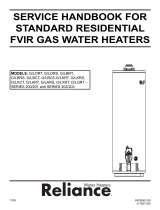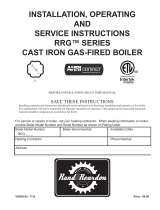Page is loading ...

www. eldcontrols.com
Please retain these instructions after installation.
This device MUST be installed by a quali ed agency in accordance with the manufacturer's installation instructions. The de nition of
a quali ed agency is: any individual, rm, corporation or company which either in person or through a representative is engaged
in, and is responsible for, the installation and operation of HVAC appliances, who is experienced in such work, familiar with all the
precautions required, and has complied with all the requirements of the authority having jurisdiction.
READ THESE INSTRUCTIONS CAREFULLY AND COMPLETELY BEFORE PROCEEDING WITH THE INSTALLATION.
Installation Date:
Installed By: Phone:
THERMAL SAFETY SWITCH
Model: TSP-1
Installation of a Thermal Safety Switch or Spillage Switch is recommended for LP and Natural Gas
red systems with draft hoods. This device is installed to detect ue gas spillage from a blocked ue
system, and/or inadequate draft. This device MUST be installed by a quali ed installer in accordance
with manufacturer's installation instructions. Wiring should be in accordance with the manufacturer's
recommendations, National Electrical Code and applicable local codes.
NOTE: For 30 Millivolt Wiring Applications, the TCA-1 Thermocouple Adapter must be ordered separately.
(Part No. 46082700)
ITEMS SUPPLIED WITH KIT:
1- Thermal Safety Switch Assembly
3- Probe Mounting Tabs
5- #8 Self-tapping Sheet Metal Screws

page 2
INSTALLATION
CAUTION: Never attempt to shorten probe
length. Avoid kinking probe while handling.
Before and after installation, it is recommended
to follow the pre-installation
inspection instructions.
NOTE: Probe length is designed for mounting on
draft hoods up to 6" Dia. Pipe size. To achieve
360° spillage sensing on larger draft hood, an
additional switch or switches would be required.
Figure 1
Figure 2
WATER HEATERS AND BOILERS
1. Mount the switch box onto the appliance 2" to 3" away
from the draft hood using two sheet metal screws. The
probe should be directed towards the draft hood. (See
Figure 1) An alternative mounting method is to mount the
switch directly onto the draft hood. (See Figure 2)
2. Mount the probe tabs around the draft hood, located
approximately 120° apart. The bottom of the bent end
should be
1
⁄2" to
3
⁄4" away from the bottom edge of the
draft hood. (See Figure 3)
3. Carefully uncoil and route the probe around the draft
hood. (See Figure 3) Avoid bending the sensing probe,
kinks can alter the switch's performance.
NOTE: For small draft hoods, multiple wraps around the
draft hood are required.
4. To secure the probe, bend the tab ends to hold the
probe secure.

page 3
Figure 3
Figure 4
FURNACES OR UNIT HEATERS
1. Mount the switch on the outside of the appliance near the draft hood. The probe should be directed
towards the draft hood.
2. Mount the probe tabs along the top edge of the draft hood. (See Figure 4) The bottom of the bent end
should be
1
⁄2 to
3
⁄4" away from the edge of the draft hood.
3. Carefully uncoil and route the probe along the draft hood. (See Figure 4) Avoid bending the sensing
probe, kinks can alter the switch's performance.
NOTE: For small draft hoods, double back with the probe using a minimum of a 1" radius to bend the
probe. (See Figure 4)
4. To secure the probe, bend the tab ends to hold the probe secure.

page 4
MILLIVOLT WIRING SYSTEM
CAUTION: Shut o main gas supply to appliance before wiring.
NOTE: TCA-1 Thermocouple Adapter (Part No. 46082700) required.
30 MILLIVOLT SYSTEM
1. Remove thermocouple from gas control valve. (See Figure 5)
2. Thread TCA-1 thermocouple adapter into thermocouple port, then
thread the thermocouple into the bottom of the TCA-1.
(See Figure 6)
3. Connect lead wires (NOTE: 12 GA wire should be used) from the
TCA-1 thermocouple adapter to the leads on the thermal switch.
(See Diagram B)
Diagram A
Figure 6
Figure 5
Diagram B
WIRING
Refer to System Check-out Procedure Section before operating.
24 VAC SYSTEMS
CAUTION: Disconnect electrical power when wiring Safety Switch.
1. Remove one of the thermostat wires from the gas control valve and wire the safety switch in series with
the thermostat circuit. (See Diagram A)
2. After installing the safety switch, check the amperage drawn through the thermostat circuit and adjust the
thermostat anticipator accordingly.

page 5
750 MILLIVOLT SYSTEM
Wire the TSP-1 thermal switch in series with one side of the thermostat circuit (See Diagram C) or pilot
generator circuit.
SYSTEM CHECK-OUT PROCEDURE
1. Push the reset on the spillage switch. Light the appliance burner in accordance with manufacturer's
instructions. Operate the appliance to determine that the appliance will operate continuously.
2. Adjust thermostat so the appliance burner is shut o . Allow system to cool down, then remove the vent
pipe connection near the appliance.
3. Block the appliance vent outlet with a noncombustible material.
4. Adjust thermostat control to call for heat. Allow approximately 2 minutes for the system ue gases to back
up and the gas burner to shut o .
5. Push the reset on the spillage switches, then relight appliance and perform Steps 3 & 4 again.
6. Re-connect vent pipe connection and cycle system 2 to 3 times to ensure continuous operation.
NOTE: Shutdown of appliance burner should not be more than 10 minutes.
Diagram C

page 6
PRE-INSTALLATION INSPECTION INSTRUCTIONS FOR EXISTING APPLIANCES
RECOMMENDED PROCEDURE FOR SAFETY INSPECTION OF AN EXISTING APPLIANCE INSTALLATION BY THE
NATIONAL FUEL GAS CODE ANSI 54, Z223.1 APPENDIX H:
The following procedure is intended as a guide to aid in determining that an appliance is properly installed
and is in a safe condition for continuing use. This procedure is predicated on central furnace and boiler
installations, and it should be recognized that generalized procedures cannot anticipate all situations.
Accordingly, in some cases deviation from this procedure may be necessary to determine safe operation of
the equipment:
a. This procedure should be performed prior to any attempt to modify the appliance or the installation.
b. If it is determined there is a condition which could result in unsafe operation, the appliance should be
shut o and the owner advised of the unsafe condition.

page 7
THE FOLLOWING STEPS SHOULD BE FOLLOWED IN MAKING THE SAFETY INSPECTION:
1. Conduct a gas leakage test of the appliance piping and control system downstream of the shut o valve
in the supply line to the appliance.
2. Visually inspect the venting system for proper size and determine there is no blockage or restriction,
leakage, corrosion, or other de ciencies which could cause an unsafe condition.
3. Shut o all gas to the appliance and shut o any other fuel-gas burning appliance within the same room.
Use the shut o valve in the supply line to each appliance.
4. Inspect burners and crossovers for blockage and corrosion.
5. Applicable only to furnaces. Inspect heat exchanger for cracks, openings, or excessive corrosion.
6. Applicable only to boilers. Inspect for evidence of water or combustion product leaks.
7. Insofar as practical, close all building doors and windows and all doors between the space in which the
appliance is located and other spaces of the building. Turn on clothes dryers. Turn on any exhaust fans,
such as range hoods and bathroom exhausts, so they will operate at maximum speed. Do not operate
a summer exhaust fan. Close replace dampers. If, after completing Steps 8 through 13, it is believed
su cient combustion air is not available, refer to local codes, or in the absence of local codes, to the
National Fuel Gas Code, ANSI Z223.1 No. 54 for guidance.
8. Place in operation the appliance being inspected. Follow the lighting instructions. Adjust thermostat so
appliance will operate continuously.
9. Determine that the pilot(s) is burning properly and that main burner ignition is satisfactory by interrupting
and reestablishing the electrical supply to the appliance in any convenient manner. Test the pilot safety
device to determine it is operating properly by extinguishing the pilot burner(s) when the main burner(s) is
o and determine, after 3 minutes, that the main burner gas does not ow upon a call for heat.
a. Visually determine that main burner gas is burning properly: i.e., no oating, lifting, or ashback.
Adjust the primary air shutter(s) as required.
b. If appliance is equipped with high and low ame controlling or ame modulation, check for proper
main burner operation at low ame.
10. Test for spillage at draft hood relief opening after 5 minutes of main burner operation. Use a draft gauge,
ame, or a match or candle, or smoke from a cigarette, cigar, or pipe.
11. Turn on all other fuel-gas burning appliances within the same room so they will operate at their full inputs.
Follow lighting instructions for each appliance.
12. Repeat Steps 10 through 12 on the appliance being inspected.
13. Return doors, windows, exhaust fans, replace dampers, and any other fuel-gas burning appliance to
their previous conditions of use.
14. Applicable only to furnaces. Check both the limit control and fan control for proper operation. Limit
control operation can be checked by blocking the circulation air inlet or temporarily disconnecting the
electrical supply to the blower motor and determine that the limit control acts to shut o the main
burner gas.
15. Applicable only to boilers.
a. Determine that the water pumps are in operating condition.
b. Test low water cuto s, automatic feed controls, pressure and temperature limit controls, and relief
valves in accordance with the manufacturer's recommendations to determine they are in
operating condition.

Phone: 252.522.3031 • Fax: 252.522.0214
www.fieldcontrols.com
© Field Controls, LLC P/N 46170300 Rev C 04/15
WARRANTY
For warranty about this or any Field Controls product, visit:
www.fi eldcontrols.com/warranty
/


